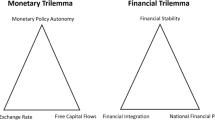Abstract
In this paper, we develop an international financial equilibrium model with hedging inthe form of futures and options contracts. We identify the network structure of the individualsectors' optimization problems out of equilibrium and establish the network structureof the entire international financial economy in equilibrium. We formulate the governingequilibrium conditions as a finite-dimensional variational inequality problem and thenpresent some qualitative properties. Finally, we propose a computational procedure, alongwith convergence results, which resolves the variational inequality problem into networksubproblems with special structure, each of which can then be solved exactly and in closedform.
Similar content being viewed by others
References
T.J. Andersen, Currency and Interest Hedging, New York Institute of Finance, New York, 1993.
F. Black and R. Litterman, Global portfolio optimization, Financial Analysts Journal 48(1992)28 – 43.
A. Charnes and W.W. Cooper, Management Models and Industrial Applications of Linear Programming, Wiley, New York, 1961.
A. Charnes and W.W. Cooper, Some network characterizations for mathematical programming and accounting approaches to planning and control, The Accounting Review 42(1967)24 – 52.
N. Christofides, R.D. Hewins and G.R. Salkin, Graph theoretic approaches to foreign exchange operations, Journal of Financial and Quantitative Analysis 14(1979)481 – 500.
J.C. Cox and M. Rubinstein, Options Markets, Prentice-Hall, Englewood Cliffs, NJ, 1985.
D. Duffie, Futures Markets, Prentice-Hall, Englewood Cliffs, NJ, 1989.
G.M. Korpelevich, The extragradient method for finding saddle points and other problems, Matekon 13(1977)35– 49.
J.M. Mulvey, Nonlinear networks in finance, in: Advances in Mathematical Programming and Financial Planning, Vol. 1, 1987, pp. 253 – 271.
A. Nagurney, Network Economics: A Variational Inequality Approach, Kluwer Academic, Boston, MA, 1993.
A. Nagurney, Variational inequalities in the analysis and computation of multi-sector, multi-instrument financial equilibria, Journal of Economic Dynamics and Control 18(1994)161 – 184.
A. Nagurney and J. Dong, General financial equilibrium modeling with policy interventions and transaction costs, Computational Economics 6(1996)3 – 17.
A. Nagurney, J. Dong and M. Hughes, Formulation and computation of general financial equilibrium, Optimization 26(1992)339 – 354.
A. Nagurney and S. Siokos, Variational inequalities for international general financial equilibrium modeling and computation, Mathematical and Computer Modelling 25(1997)31 – 49.
A. Nagurney and S. Siokos, Dynamics of international financial networks: Modeling, stability analysis, and computation, in: Networks and Knowledge in a Dynamic Economy, eds. M. Beckmann, B. Johansson, F. Snickars and R. Thord, Springer, Berlin, Germany, 1997, in press.
A. Nagurney and S. Siokos, Dynamic multi-sector, multi-instrument financial networks with futures: Modeling and computation, 1996, to appear in Networks.
F. Quesnay, Tableau Economique, 1758, reproduced in facsimile with an introduction by H. Higgs by the British Economic Society, 1895.
A. Rudd and B. Rosenberg, Realistic portfolio optimization, in: TIMS Studies in Management Science, Vol. 11, 1979, pp. 21 – 46.
D.P. Rutenberg, Maneuvering liquid assets in a multi-national company: Formulation and deterministic solution procedures, Management Science 16(1970)671 – 684.
P.A. Samuelson, Spatial price equilibrium and linear programming, American Economic Review 42(1952)283 – 303.
T. Takayama and G.G. Judge, Spatial and Temporal Price and Allocation Models, North-Holland, Amsterdam, The Netherlands, 1991.
S. Thore, Credit networks, Economica 36(1969)42– 57.
S. Thore, Programming the Network of Financial Intermediation, Universitetsforlaget, Oslo, Norway, 1980.
S. Thore, Spatial models of the Eurodollar market, Journal of Banking and Finance 8(1984)51 – 65.
S. Wallace, Solving stochastic programs with network recourse, Networks 16(1986)295 – 317.
Rights and permissions
About this article
Cite this article
Nagurney, A., Siokos, S. Network modeling of international financialequilibria with hedging. Annals of Operations Research 82, 139–160 (1998). https://doi.org/10.1023/A:1018950300861
Issue Date:
DOI: https://doi.org/10.1023/A:1018950300861




